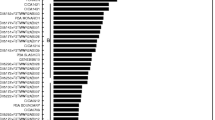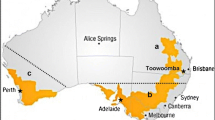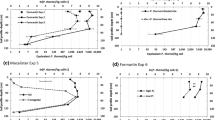Abstract
Crop growth and damage parameters (plant growth and yield, root damage and nematode population densities), believed to be associated with resistance of Musa genotypes to nematodes under field conditions, were evaluated in a field trial of 24 Musa genotypes inoculated at planting with a combination of Radopholus similis and Helicotylenchus multicinctus with the objective to identify parameters with strong association with nematode resistance and high heritability. Correlation and path analysis of the association between plant growth, yield, root damage and nematode population densities showed a strong negative association between percentage dead roots, percentage root necrosis, R. similis and H. multicinctus population densities and yield. The strongest negative association was observed between percentage dead roots and yield. Broad-sense genotype heritability estimates demonstrated that heritability estimates for percentage dead roots, number of large lesions and nematode population density were most affected by inoculation with nematodes. These results indicate therefore that effective selection for nematode resistance under field conditions could be obtained by using an index, that includes percentage dead roots, the number of large lesions, and nematode population density.

Similar content being viewed by others
References
Becker WA (1984) Manual of quantitative genetics, 4th edn. Academic Enterprises, Pullman, WA
Board JE, Kang MS, Harville BG (1997) Path analyses identify indirect selection criteria for yield of late-planted soybean. Crop Sci 37:879–884
Davide RG (1996) Overview of nematodes as a limiting factor in Musa production. In: Frison EA, Horry J-P, De Waele D (eds) New frontiers in resistance breeding for nematode, fusarium, and sigatoka. Proceedings of a workshop Kuala Lumpur, Malaysia 2–5 October, 1995. INIBAP, Montpellier, France pp 27–31
De Schutter B, Speijer PR, Dochez C, Tenkouano A, De Waele D (2001) Evaluating host plant reaction of Musa germplasm to Radopholus similis by inoculation of single primary roots. Nematropica 31:297–301
De Waele D, Elsen A (2002) Migratory endoparasities: Pratylenchus and Radopholus species. In: Starr JJ, Cook R, Bridge J (eds) Plant resistance to parasitic nematodes. CAB International, Wallingford, UK, pp 175–206
Dochez C, Whyte J, Tenkouano A, Ortiz R, De Waele D (2005) Response of East African highland bananas and hybrids to Radopholus similis. Nematology 7:655–666
Dochez C, Speijer PR, De Schutter B, Dubois T, Tenkouano A, De Waele D, Ortiz R (2009) Host plant resistance and tolerance of Musa landraces and hybrids to nematode infestation. J Agric Rural Dev Trop Subtrop Suppl 92:137–153
Elsen A, Goossens B, Belpaire B, Neyens A, Speijer PR, De Waele D (2004) Recolonisation by nematodes of hot water treated cooking banana planting material in Uganda. Nematology 6:215–221
Fogain R, Gowen S (1995) Susceptibility to Radopholus similis among triploid Musa cultivars in relation to growth of root systems. Nematologica 41:300–308
Gowen SC, Quénéhervé P, Fogain R (2005) Nematode parasites of bananas and plantains. In: Luc M, Sikora RA, Bridge J (eds) Plant parasitic nematodes in subtropical and tropical agriculture, 2nd edn. CAB International, Wallingford, UK, pp 611–643
Hauser S (2000) Effects of fertilizer and hot-water treatment upon establishment. Survival and yield of plantain (Musa spp., AAB French). Field Crop Res 66:213–223
Hooper DJ, Hallman J, Subbotin S (2005) Methods for extraction, processing and detection of plant and soil nematodes. Nematode parasites of bananas and plantains. In: Luc M, Sikora RA, Bridge J (eds) Plant parasitic nematodes in subtropical and tropical agriculture, 2nd edn. CAB International, Wallingford, UK, pp 53–86
Jagtap S (1993) Diagnostic survey site selection using GIS for effective biological and integrated control of highland banana pests. In: Gold CS, Gemmel B (eds) Biological and integrated control of highland banana pests and diseases in Africa. Proceedings of a Research Coordination Meeting 12–14 November 1991, IITA, Cotonou, Benin. The Printer, Davis, CA, USA, pp 25–36
Kashaija IN, Speijer PR, Gold CS, Gowen SR (1994) Occurrence, distribution and abundance of plant parasitic nematodes on bananas in Uganda. Afr J Crop Sci 2:99–104
McGiffen ME, Pantone DJ, Masiunas JB (1994) Path analysis of tomato yield components in relation to competition with black and eastern black nightshade. J Am Soc Hortic Sci 119:6–11
Ortiz R (1998) AMMI and stability analyses of bunch mass in multilocational testing of Musa germplasm in sub-Saharan Africa. J Am Soc Hortic Sci 123:623–627
Pinochet J (1996) Review of past research on Musa germplasm and nematode interactions. In: New frontiers in resistance breeding for nematode, fusarium, and sigatoka Proceedings of a workshop Kuala Lumpur, Malaysia 2–5 October, 1995. INIBAP, Montpellier, France, pp 32–44
Pinochet J, Rowe PR (1979) Progress in breeding for resistance to Radopholus similis on bananas. Nematropica 9:76–77
Price NS (1994) Field trial evaluation of nematode susceptibility within Musa. Fundam Appl Nematol 17:391–396
Quénéhervé P, Valette C, Topart P, Tezenas du Montcel H, Salmon F (2009) Nematode resistance in bananas: screening results on some wild and cultivated accessions of Musa spp. Euphytica 165:123–136
Sachs L (1986) Applied statistics—a handbook of techniques. Springer-Verlag, New York, USA
Sarah JL (1989) Banana nematodes and their control in Africa. Nematropica 19:199–216
SAS Institute (1996) The SAS system for Windows release 6.12. SAS Institute Inc., Cary, NC, USA
Sasser JN, Freckman DW (1987) A world perspective on nematology: the role of the society. In: Veech JA, Dickson DW (eds) Vistas in nematology. Society of Nematologists, Hyattsville, MD, USA, pp 7–14
Severn-Ellis AA, Daneel M, de Jager K, De Waele D (2003) Development of an aeroponic system to study the response of banana roots to infection with Fusarium oxysporum f. sp. cubense and Radopholus simlis. InfoMusa 12:22–24
Simmonds NW (1995) Bananas: Musa (Musaceae). In: Smart J, Simmonds NW (eds) Evolution of crop plants, 2nd edn. Longman Scientific and Technical, Essex, UK, pp 370–375
Sokal RR, Rohlf FJ (1995) Biometry: the principles and practices of statistics in biological research, 3rd edn. Freeman and Co., New York, USA
Speijer PR, De Waele D (1997) Screening of Musa germplasm for resistance and tolerance to nematodes. INIBAP Technical Guidelines I. INIBAP, Montpellier, France
Speijer PR, Fogain R (1999) Musa and Ensete nematode pest status in Africa. In: Karamura EB, Gold CS (eds) Banana IPM. Proceedings of the workshop, Nelspruit, South Africa, 23–26 November, 1998. INIBAP, Montpellier, France pp 99–118
Speijer PR, Gold CS, Kashaija IN, Karamura EB (1994) Assessment of nematode damage in East African highland banana systems. In: Valmayor RV, Davide RG, Stanton JM, Treverrow NL, Roa VN (eds) Banana nematodes and weevil borers in Asia and the pacific. Proceedings of the workshop Serdang, Selangor, Malaysia 18–22 April, 1994. INIBAP/ASPNET, Los Banos, Philippines, pp 191–203
Speijer PR, Kajumba C, Ssango F (1999) East African highland banana production as influenced by nematodes and crop management in Uganda. Int J Pest Manag 45:41–49
Speijer PR, Gold CS, Goossens B, Karamura EB, Elsen A, De Waele D (2000a) Rate of nematode infestation of clean banana planting material (Musa spp. AAA) in Uganda. Acta Hortic 540:461–467
Speijer PR, Ssango F, Vuylsteke D (2000b). Evaluation of host plant response to nematodes in Musa germplasm in Uganda. In: Craenen K, Ortiz R, Karamura BE, Vuylsteke DR (eds) Proceedings of the first international conference on banana and plantain for Africa, Kampala, Uganda, 14–18 October 1996. Acta Hortic 540:225–232
Ssango F, Speijer PR, Coyne DL, De Waele D (2004) Path analysis: a novel approach to determine the contribution of nematode damage to East African Highland banana (Musa spp., AAA) yield loss under two crop management practices in Uganda. Field Crop Res 90:177–187
Swennen R, Vuylsteke D (2001) Banana. In: Raemaekers RH (ed) Crop production in tropical Africa. Directorate General for International Co-operation, Ministry of Foreign Affairs, External Trade and International Co-operation, Brussels, Belgium, pp 530–552
Tenkouano A, Swennen RL (2004) Progress in breeding and delivering improved plantain and banana to African farmers. Chron Horticult 44:9–15
Timm NH, Mieczkowski TA (1997) Univariate and multivariate general linear models: theory and applications using SAS® software. SAS Institute Inc., Cary, NC, USA
Vuylsteke D (2000) Breeding bananas and plantains: from intractability to feasibility. In: Craenen K, Ortiz R, Karamura BE, Vuylsteke DR (eds) Proceedings of the first international conference on banana and plantain for Africa, Kampala, Uganda, 14–18 October 1996. Acta Horticult 540:149–156
Acknowledgements
This publication is dedicated to the memory of John Hartman, Dirk Vuylsteke and Paul Speijer who died tragically in an air crash on January 30, 2000. The assistance of Jim Lorenzon, IITA banana breeder, in preparing this manuscript is greatly appreciated.
Author information
Authors and Affiliations
Corresponding author
Additional information
John B. Hartman, Dirk Vuylsteke and Paul R. Speijer died on January 30, 2000.
Rights and permissions
About this article
Cite this article
Hartman, J.B., Vuylsteke, D., Speijer, P.R. et al. Measurement of the field response of Musa genotypes to Radopholus Similis and Helicotylenchus Multicinctus and the implications for nematode resistance breeding. Euphytica 172, 139–148 (2010). https://doi.org/10.1007/s10681-009-0104-4
Received:
Accepted:
Published:
Issue Date:
DOI: https://doi.org/10.1007/s10681-009-0104-4




